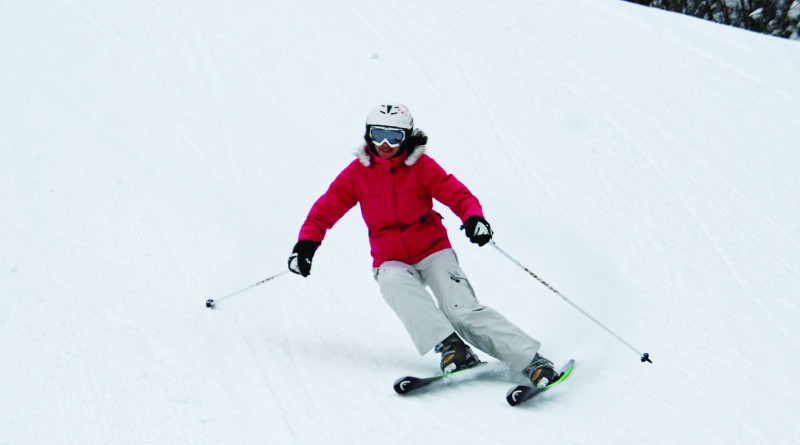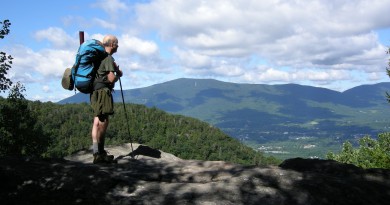GET A GRIP! Five Ways to Ski Better on “Firm Snow”
By Lisa Densmore
To be politically correct in the world of snow reporting, when the surface of a trail ceases to have flakes on it and becomes very hard and sometimes more blue or green than white, it’s called “frozen granular.” In ski school vernacular, it’s called “firm snow.”
My sweetheart, Jack, a Montanan who skied in Vermont for the first time four years ago, calls it “loud.” Unfortunately, his debut at a ski area in the Green Mountains was after one of those January thaws when it pours rain for 24 hours then the temperature plummets.
“I’d always thought if I could hear my skis I was skidding, making a bad turn,” said Jack, “Here, I hear every turn! I thought I had forgotten how to ski.”
As a lifelong Vermont skier, I had never given skiing’s audio cues a thought until Jack brought it up. I had become so accustomed to the noise, I’d ceased to hear it. That said, the slopes in Vermont are a lot quieter than they were in my formative years.
In truth, this part of the skiing world has an undeserved reputation for firmer-than-desirable snow. Snowmaking systems have become so advanced, the corduroy here is usually on par and sometimes better than in the West. And with modern grooming machines, a ski area can recover from a thaw-freeze cycle usually within 24 hours. However, if it’s less than 24 hours or late afternoon on a weekend after lots of skier traffic, things can get a little scratchy.
It’s a common tendency for a skier to freeze up as stiff as, well I’ll just say it, the ice itself, which greatly hampers performance and kills one’s confidence. But if you’re going to ski the Greens, you’re likely going to encounter hard-pack, so we want you to be ready to ski it the best that you can.
Here are five tips to help your ski edges get a better grip.
- Pick the right skis. The coolest skis in the lift line might be the fully rockered, super-wide twin-tips, but these fatties are performance underdogs on hard-pack. To hold an edge, a ski must be torsionally stiff. Fat skis (more than 90 mm in the waist) tend to be soft. What’s more, if the ski is rockered or has a lot of early rise in the tip, it won’t grip as well as a traditionally cambered ski. The party line says the pre-bend in the tip helps you enter the turn easier, which may be true, but a soft, rockered tip isn’t doing much more than getting out of the way. To hold on ice, you must “carve” turns, which starts with purposefully engaging your ski tips as you enter each turn, then rolling the ski on edge more and more as the turn progresses.
- Tune your skis. You can have the best skis in the world, but if your edges are dull or burred, they won’t hold. Lightly scrape your thumbnail across your edges in different spots. If your nail leaves tiny shavings, you’re edges are sharp. Your edges should also be smooth and rust-free. If the snow is firm, you may need to tune your skis (or have an expert do it) after every two days or so. Once you tune your skis, if they feel “grabby,” dull the tips and tails about two inches down the running surface to help your skis glide in and out of turns easier.
- Get forward. If you feel anxious on ice, you’re probably sitting back, which gives you even less control. Your shins should be pushing against the tongues of your ski boots 100 percent of the time. Relax your toes! If you clench your toes, your whole body will stiffen and your shins will pull away from your boot tongues. When trying to get forward more, a common mistake is to bend too much at the waist. Your chest should face forward. If it’s pointing at your skis, you’re bent too much. Another common mistake is trying to get forward by bending the knees more, but that results in sitting back even further unless you flex your ankles too. To get forward, concentrate mainly on flexing at the ankles.
- Keep your hands forward. What you do with your hands affects what’s happening down below. If your uphill hand drops, you’ll lean into the hill, flattening your skis and losing your edge grip. If both hands drop, your weight will move back, flattening your skis and putting you off balance, a bad combination on ice. If your hands are level with your belly button and they’re slightly wider than your hips, they’re in the right spot.
- Lean down the hill. The least intuitive part of ski technique is leaning down the hill during the second half of a turn, but it’s critical for holding on hard-pack. If you lean toward the base lodge, your body naturally compensates by angling your hips, knees, and ankles into the hill thus putting your skis on edge. The more you lean down the hill, the higher the edge angle and the better the edge-grip. Likewise, the steeper the slope and the firmer the snow, the more you need to lean down the hill, concentrating your weight on the downhill (outside) ski.
- Shorten your turns. Lastly, get off your edges! This might sound peculiar, as the whole purpose of this article is to tell you how to get on your edges. However, after they bite, release them. If you hang on, you’ll start sliding. If you get off your edges quickly, making shorter turns down the hill, you’ll have better edge-grip and more control.
ADAPTING TO OTHER ADVERSE SKI CONDITIONS
Powder is paradise to some skiers and hell to others. Ditto spring corn snow. The older and deeper powder and corn become, the heavier they become, especially if lots of skiers have made tracks ahead of you.
If you’re the type who can’t relate to the hype after a snowstorm, you may be trying to ski ungroomed snow like the corduroy. Rather than emphasizing the weight on your outside (downhill) ski, distribute it more evenly over your skis, about 60 percent on the downhill ski, 40 percent on the uphill ski. Don’t sit back! You’ll fry your thighs and likely lose your balance. The key in powder or ungroomed snow is to direct your uphill ski as purposefully as your downhill ski so it doesn’t get snagged in the snow. And if your skis are narrower than 80 mm in the middle, consider renting a pair of fatties, 90 mm or wider. You won’t get as bogged down in the crud.
A four-time world masters champion in Alpine skiing, Lisa Densmore is a USSCA-certified ski coach. She also hosts women’s ski clinics throughout the United States. www.lisadensmore.com


